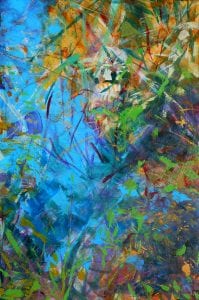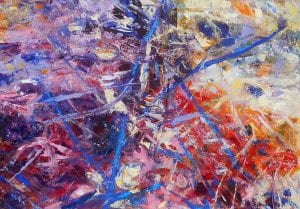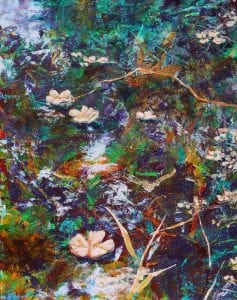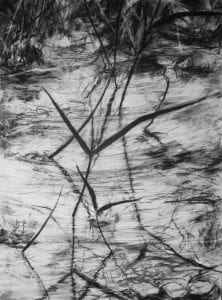September 14, 2019 | By Sarah Telesca
On view through November 17
at Brooker Creek Preserve
Tarpon Springs
More here

Nathan Beard’s name, face or work might seem familiar to you, but if you’re unable to remember where from, there might be a simple reason. Beard is an active studio artist, father, Assistant Curator for the Dunedin Fine Art Center and was a 2017 recipient of the Creative Pinellas Emerging Artists Grant.
Beard’s newest works in Drawing Water were created partially out of an intrinsic need to create as he entered a new stage in his life. This became the series Pond’s Edge, a less abstract collection than most of his previous work.
As a routine of going down to the water’s edge started to take shape, he took note of how meditative the water was, allowing for a calm moment of pause. This led him to try to reconcile that pause with the endlessly changing landscape and the living things that exist outside of our view, as well as “living” things inside of ourselves.
Creative Pinellas talked to Beard as he navigated the busy timeline of his life, taking pause to mull over mutable memories and our intersections with nature.
I love in the podcast that you did with Barbara St. Clair, when you said “Something on water never stays where it’s supposed to, just like our brains.” You took your daughter to the pond when she was young, marking a distinctive time in your lives, yet a fleeting one in the pond’s timeline.

Those moments were fleeting for us, too. I feel like my memory of those moments keeps changing over time, partly due to age – and partly in response to my daughter’s ability to recall and describe events in her own words.
The purpose of the Pond’s Edge work only dawned on me a couple of years ago when I noticed that making the paintings and drawings was a psycho-emotional countermeasure to my abstract body of work, Exit Music, and not just something I did to maintain my drawing skills or try out new processes.
As Pond’s Edge ages, its purpose becomes more expansively adaptable. For example, in the context of the Brooker Creek exhibition, the works presented can act as a catalyst for thought and discussion about the importance of our emotional response to landscape as a vital complement to our logical understanding of it.
I really love the concept that exhibit curator Lynn Whitelaw and Brooker Creek Preserve have created, showcasing nature-inspired art, in and around the nature that inspired it. Did you have any inkling that your work would end up in such a unique showcase situation?
I love Lynn’s collaboration with Brooker Creek as well, especially as part of a larger culture-wide move towards reintegrating the arts and sciences.

I could have never foreseen our working together, since I started this series before I knew much of anyone in the area. Pond’s Edge came out of a very personal need to paint something new and to find some new passion or viewpoint in direct relation to fatherhood and navigating the waters of being a stay-at-home dad.
I am so happy that the work will be in view of the kind of landscape inspiring it. The floor to ceiling windows of the exhibit space will allow instant connection between the wetland and the artwork. In many ways, it is the perfect setting and I am unendingly grateful to Lynn for inviting me to exhibit there. I hope that viewers will be able to come away with a new ability to see patterns on the water in a new way and that they will be able to find beauty wherever they may be.
Can you talk about the idea of things being written on water as you created paintings in a visual, not a written language?
Our minds are never still, chemicals and electricity pulse rapidly without our permission or cognizance. Thoughts and memories do so as well, and it is this shifting psychological landscape that I am most interested in, as well as the way that humans construct stories about themselves, stories that are never quite complete or true… or false. Stories that are malleable and adaptable, that given time, become a kind of poetry that we can hand down to our children and grandchildren.
The fluidity of ideas through time and their ability to sculpt the reality of those that receive them is very important to my understanding of the world and operation within it. My Pond’s Edge series is a personal, psychological reflection upon the observation and reception of this fluid poetry.

How much of a role does living specifically in Florida weigh into your work?
We moved here from Denver, where the landscape is vast and seemingly empty, in comparison to Florida.
What I have connected to most is the floral profundity and density of this landscape. There is a sense, and a reality of things remaining hidden from view. The concept of layers has always entranced me and I find the weaving of mangrove roots and underwater hydrilla intoxicating. Metaphorically applying layers, hidden mysteries and natural rhythms to my work allows me to meditate upon microscopic and macroscopic connections.
Where is the line between abstract and representational in “Pond’s Edge?”
The line between the two lies in the interpretive nature of my process and the presentation of a final image that is removed from original context.
To ‘abstract’ is by definition to simplify or condense, and since I am incapable of reproducing every single detail of a natural scene, I have to resort to interpreting a scene. So for instance, in our waterways, there is an overwhelming amount of sticks, plants, leaves, etc. that, for the sake of sanity and design, I either leave out a lot of it or replace it with something of my own making informed by memory.

Also, many of the reference photos I take are from manipulated environments, as opposed to pristine. Florida is well-known for its canal-drainage systems that allow much of human development to stay above waterline and table. The paintings and drawings, though, focus very closely on a shoreline scene, rather than the context at large — and can have the effect of a romantic or impressionistic view of nature and reflections on water.
The point for me is to be able to find beauty in any situation, even at the confluence of canal and sluice pipe and in all the environmental challenges and problems that arise from draining wetlands for habitation. It’s a way of personally dealing with the reality that I find myself in, that I had little or nothing to do with its creation, and most often feel ineffectual in reforming.
Brooker Creek, however, has provided me the opportunity to reference a pristine Florida environment, which is why I think I felt compelled and free to try to capture its wildness through a more loose and abstracted creative approach in the four new works made specifically for this exhibition.
Can you elaborate a bit on your comparison of “humanity’s imbalanced approach to nature [being] a boat quickly drawing water?”
It’s no secret that humans have an impact on their environment. We don’t even need to get into contentious arguments over planet-wide climate change — we only need look in Florida’s backyard.
Even a cursory study of the situation in the Everglades is evidence enough that human intervention in the landscape can have disastrous consequences for both nature and humans, and that any development we pursue — anywhere — needs to be well-thought out. There is no room for ignorance and greed anymore. Humans are intelligent and adaptable, and there is no reason that we can’t balance our species’ needs with the needs of the only habitable planet in the universe through new technologies, approaches to food and housing, and most importantly, elevated awareness of our place in the web of life.
If you would like to see the show after the opening weekend,
please call Brooker Creek Preserve to arrange a time at
727-934-2680.
Drawing Water opens
on Sunday, September 15
with a reception from 1-3 pm
On display until November 17
More here
For more on curator Lynn Whitelaw’s work
at Brooker Creek Preserve, see this feature in Creative Loafing.


